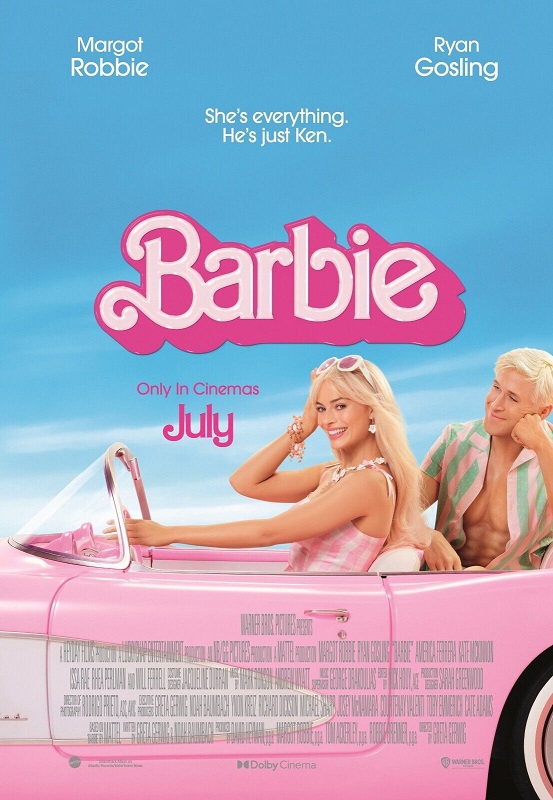

2023 – Barbie
This movie was way better than I was expecting. I mean, I wasn’t expecting it to be bad. After all, I had heard about how much it was loved by people across the spectrum, from adults and children, from men and women, from fans to skeptics. It was good on so many levels. It was visually stunning, cleverly written, perfectly cast, didn’t take itself too seriously, was laugh-out-loud funny, and yet had some serious and relevant commentary on our modern society. It had a lot to say, and said it in a way that was direct and to the point, only a little bit preachy, and yet palatable. And when it comes down to it, it was just plain fun!
First, let me mention the set design, which ties into the intelligent script. About two thirds of the movie takes place in the fictional Barbieland. They filmmakers paid a lot of great attention to the history of the toy line. They featured all the popular items like Barbie’s dream House, and Barbie’s pink Cadillac. They also featured many versions of Barbie that have actually been produced, both the successful ones, and the bombs.
Directed by Greta Gerwig, the film didn’t shy away from looking at both the positive and negative sides of the toy and its impact on the modern world. It is part of what made the movie so controversial, and so good. Wikipedia did a great job of summarizing some of these contradictions, and I’d like to share what I’ve found:
“Gerwig was influenced by her childhood experiences with Barbie. Her mother discouraged her from purchasing such dolls, but eventually allowed her to. Opting to acknowledge the controversial nature of the Barbie doll, Gerwig chose to create a film where she would be both “doing the thing and subverting the thing”, in the sense that she would be celebrating the feminism behind Barbie while also noting the controversial beauty standards associated with it. She was also fascinated by the idea that humans created dolls, which in turn imitate humans, feeling that “we’re in constant conversation with inanimate objects” while also conveying an affirmative message to the audience to “just be yourself and know that that’s enough.” The film deliberately juxtaposed contradictory messaging, such as critiquing consumerism yet glamorizing plastic products; and in the film’s ending, where Barbie desires to be more than just a plastic doll. Gerwig made the film as an “earnest attempt to make amends” between affirming womens’ worth and conveying the impossibility of perfection, which some perceived to be standards associated with Barbie.”
Margot Robbie played the title character of Stereotypical Barbie perfectly. She, as always, was gorgeous, and has a thousand wat smile. Playing opposite her was Ryan Gosling as Beach Ken. They were both awesome! Now, aside from them, Barbieland was populated with lots of other Barbies like President Barbie, Lawyer Barbie, Doctor Barbie, and so on. The Kens had Tourist Ken, Basketball Ken, and Artist Ken. The point was made that Barbieland was run by the Barbies, and that the Kens were only there as their accessories. It flipped the gender stereotypes of the real world, which has historically been run by men, with women as being the ones who are marginalized.
But when Barbie’s perfect world is interrupted with thoughts of mortality, she begins having real-world problems like depression, bad breath, and flat feet. So at the advice of Weird Barbie, played by Kate McKinnon, a Barbie who was played with too hard, and now has chopped up hair, marker lines all over her face, and legs that are generally in the splits, Barbie goes to the real world to find the girl playing with her, in order to clear up all her negative thoughts and heal her. Ken, who can only be happy when he is with Barbie, goes with her.
In the real world, Barbie finds sexism and depression, while Ken finds acceptance and power, even though it is all imagined. He returns to Barbieland and uses what he has learned to take over everything and brainwashing the Barbies into forgetting their empowering careers as Supreme Court Justices and Authors, and taking on submissive roles like casual girlfriends and maids. And that’s the main conflict of the story. Hijinks ensues.
But there was so much more that happened, more than I can fit into this review. America Ferrera and Arianna Greenblatt played Gloria and Sasha, a mother and daughter who are Barbie’s real world owners. Will Farrell played the CEO of Mattel, and Rhea Perlman played the ghost of Mattel’s co-founder and first president, Ruth Handler. And of course, the voice of Hellen Miren shows up periodically as a narrator, who often broke the fourth wall to speak directly to the audience. And I have to make special mention of the music in the opening Barbieland sequences, both the first morning, and the existential morning of Barbie’s difficulties, which sang about what was happening on the screen, using lines like “Ooo, that‘s cold,” when Barbie’s shower put out cold water. It was so funny and clever, and showed that the movie had a great sense of humor. But it was Gloria’s great speech that spelled out the real world problems that modern women have to deal with, which gave the film its appropriate bite. Yeah, Barbie just got real.








